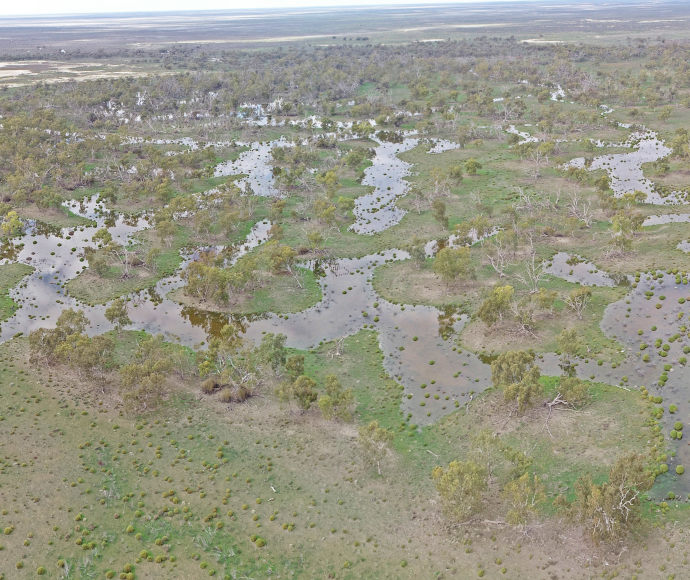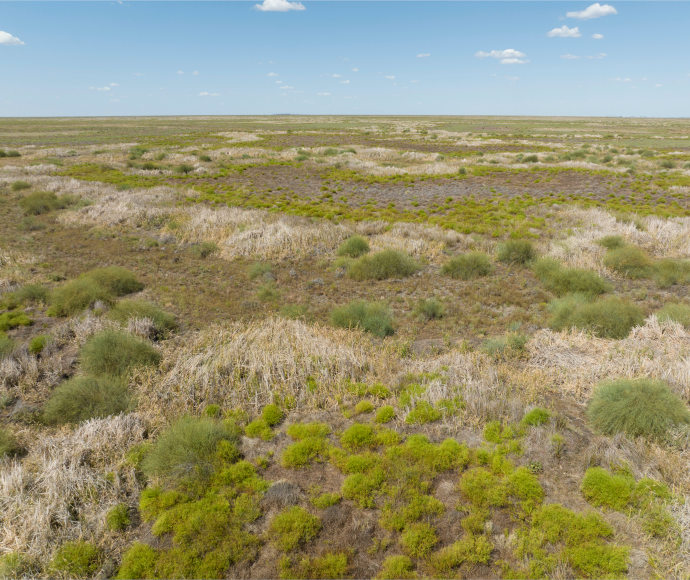How water for the environment sparked an incredible transformation of lower Merrowie Creek floodplain
Community collaboration and consecutive wet years have sparked an incredible transformation of the lower Merrowie Creek floodplain to the wetlands of Lake Tarwong.
Favourable conditions and environmental flows, managed by the NSW Government’s Water for the Environment program, have revitalised the channel floodplain country across several properties from below Booligal to north of Oxley in the Lachlan catchment.
NSW Senior Environmental Water Management Officer, Dr Jo Lenehan, is working with landholders along Merrowie Creek to help restore this nationally significant part of the system, listed in the Directory of Important Wetlands of Australia.
‘It’s one of those areas, like many locations, which used to receive more regular inundation,’ Dr Lenehan said.
‘Historically, it had healthy, robust areas of lignum, a native Australian plant.
‘It was a prime foraging and breeding habitat for waterbirds. Lake Tarwong itself was once a thriving breeding site for waterbirds that nest together in large groups.
‘Increasing the extent and condition of lignum shrublands over 2025–29 is one of the objectives in the Lachlan catchment’s long-term water plan.'
Dr Lenehan explained that it is particularly challenging to deliver environmental water to these lower reaches, given the Merrowie Creek system stretches 390 km from where it leaves the Lachlan River above Hillston.
Hit hard during the Millennium Drought, recovery of this floodplain was thought to be beyond the reach of environmental water managers.
‘It is a forgotten part of the Lachlan catchment as it is very isolated and doesn’t receive any regulated flow,’ Dr Lenehan said.
‘Everyone has always claimed it is too hard to get water to Tarwong – [as though] you need so much water, massive local rainfall, and everything must go your way,’ she said.
When extended wet conditions were forecast in 2021, Dr Lenehan believed it was the ideal time to target these areas that had been denied water for so long.
Working closely with local landholders, water for the environment was first delivered from the nationally significant wetland complex Cuba Dam, to Lake Tarwong 3 years ago.
It has been the recent involvement and collaboration of all the Merrowie Creek landholders from top to bottom that has been the turning point in being able to water the majority of the system.
Recent monitoring has revealed positive results.
‘When we last visited, the landscape was dominated by roly-poly and other terrestrial chenopods. There were sclerolaenas from one end to the other, and that was mainly it,’ Dr Lenehan said.
‘There were no cumbungi, reeds, or rushes. The opposite is now true, and the transformation has been incredible.
‘Lignum that was merely woody stumps, with no foliage, are now bushy and full of new growth, and now provide important habitat for a range of native animals – such as endangered southern bell frogs and once regionally iconic Australian bustard.
‘Other areas have seen new regeneration or more dense clumps of smaller lignum that weren’t there before.
‘Drone imagery was captured from before and after the flows, for comparison, and areas were documented with GPS for future monitoring.’
Lachlan Environmental Water Advisory Group chair Mal Carnegie said this data would be used to plan future environmental watering actions.
‘We met with landholders, collecting their insights to map out the areas where we can potentially “retain the gains” by delivering future follow-up environmental flows,’ Mr Carnegie said.
‘Achieving outcomes is only possible if we continue to work together and focus on the system as a whole.’
A follow-up environmental flow was delivered in April 2024 to re-water areas and support continued recovery.
‘We can’t water everything, so we are incredibly strategic in deciding which wetlands we target and where we can achieve the best outcomes,’ Mr Carnegie said.
Future vegetation monitoring is planned in collaboration with the Commonwealth Environmental Water Holder and the University of Canberra to track vegetation response over time.
‘The resilience we’ve seen on the floodplain is beyond what I thought possible,’ Dr Lenehan said.
‘The challenge for us is being realistic about what we can and can’t water and putting a monitoring program in place to learn from that.’

